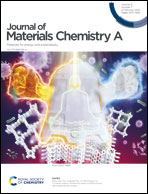Visible and infrared solar radiation upconversion for water splitting via a surface plasmon-passivated strategy†
Abstract
The current photocatalytic technology for water splitting is usually localized in specific short-wavelength photons. Herein, surface plasmon resonance (SPR) of noble metals is used to respond to a broad solar spectrum, and to design polydopamine-passivated particulate photocatalysts for widely used visible-infrared water splitting. This plasmon-passivated effect promotes the charge transfer for the hydrogen and oxygen evolution reactions to enter the Marcus inverted region for overcoming the kinetics barrier. Remarkably, this effect can also, facilitate thermodynamic upconversion processes for making efficient use of long-wavelength photons. Thus, its dequantization property should be insensitive to the energy-band structure and the energy loss would be mainly due to thermalization related to the incident power. When incident power is increased to 14 suns intensity, the efficiency in 500–750 nm region is up to 1.53%, which is a significant breakthrough for a particulate photocatalyst. Evidently, this plasmon-passivated strategy can solve the thermodynamic and kinetic challenges of photocatalysis and greatly promote visible-infrared solar water splitting applications.



 Please wait while we load your content...
Please wait while we load your content...